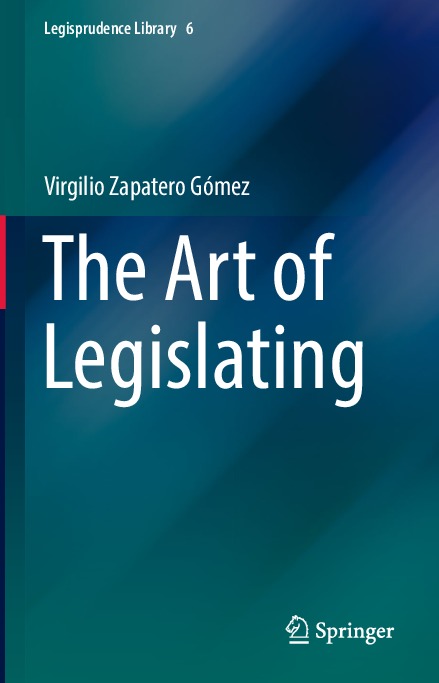File #2637: "2019_Book_TheArtOfLegislating.pdf"
Testo
1|Preface|6
2|References|8
1|Contents|9
1|About the Author|12
1|Chapter 1: Introduction: The Study of Legislation|14
2|References|20
1|Chapter 2: The Dignity of Laws|23
2|2.1 The Doubts of Our Time|23
2|2.2 Legitimacy Problems|24
2|2.3 The Dispute Over Quality|26
2|2.4 The Alleged Inflation|28
2|2.5 The Dignity of Regulation|31
2|References|33
1|Chapter 3: Laws Under Suspicion|36
2|3.1 Legislation and Public Interest|36
2|3.2 Capturing the Legislator|38
2|3.3 Public Choice and Its Premises|40
2|3.4 Politics Without Romanticism|42
2|3.5 A Few Exceptions|46
2|3.6 In Search of Another Theory of Legislation|47
2|References|51
1|Chapter 4: The Design of Laws|53
2|4.1 Laws and Reasons|53
2|4.2 Laws to Solve Problems|58
2|4.3 Identifying Objectives|62
2|4.4 Various Solutions|66
2|4.5 Evaluation of Options|67
2|4.6 In Favor of a Legislative Policy Office|72
2|References|74
1|Chapter 5: Legislative Policy|76
2|5.1 To Intervene or Not to Intervene|76
2|5.2 The Market as a Regulatory Policy|79
2|5.3 A Well-Equipped Toolbox|84
2|5.4 Legislative Policy|87
2|References|90
1|Chapter 6: A Soft Law|92
2|6.1 New Paths|92
2|6.2 Companies to Develop Norms|94
2|6.3 Self-Regulation|98
2|6.4 Reinforced Self-Regulation|101
2|6.5 Indirect Self-Regulation|105
2|References|108
1|Chapter 7: The Art of Regulating|110
2|7.1 Reward and Punishment|110
2|7.2 Information and Persuasion|111
2|7.3 Incentive-Based Regulation|113
2|7.4 Directive-Based Regulation|117
2|7.5 Norms Requiring the Provision of Information|119
2|7.6 Goal or Target Norms, Performance Norms, and Specification Norms|121
2|7.7 Authorisations and Licences|124
2|7.8 Commercialisation of Licences|126
2|References|127
1|Chapter 8: Models of Legislative Drafting|129
2|8.1 The Protagonism of Governments|130
2|8.2 The Continental European Drafting System|132
2|8.3 The Anglo-Saxon System|134
2|8.4 The U.S. Drafting System|137
2|8.5 The Spanish System|138
2|8.6 A Comparison Between Systems|142
2|References|145
1|Chapter 9: The Drafter´s Tasks|147
2|9.1 First Steps|147
3|9.1.1 Goal-Setting|149
3|9.1.2 Choossing the Appropriate Normative Tool|151
3|9.1.3 Inserting the Norm in the Existing Framework|151
3|9.1.4 First Sketch and Structure of the Text|153
2|9.2 Drafting the Text|155
3|9.2.1 Mastery of Language|156
3|9.2.2 Problems Arisen from Ambiguity|157
3|9.2.3 The Virtues of Vagueness|159
3|9.2.4 Precision Versus Clarity|160
3|9.2.5 Two Styles of Drafting: English and Continental-European|162
3|9.2.6 Delegations|166
2|9.3 The Critical Review of Drafts|167
2|References|168
1|Chapter 10: The Drafter´s Deontology|172
2|10.1 The Drafter and the Genesis of Norms|172
2|10.2 Drafters and Jurists|174
2|10.3 Materials for a Code of Conduct|176
2|References|182
1|Chapter 11: Implementation|184
2|11.1 Implementation|184
2|11.2 Taking Memoranda Seriously|189
2|11.3 Analysing the Impact of Norms|193
2|References|198
1|Chapter 12: Government and Parliament|200
2|12.1 The Legislative Agenda|200
2|12.2 Government and the Production of Laws|203
2|12.3 The Role of Parliament|207
2|References|210
1|Chapter 13: Legislators and Judges|212
2|13.1 The Judge as an Agent|212
2|13.2 New Proposals|214
2|13.3 Interpretation and Theory of Legislation|217
2|13.4 Interaction Between Legislators and Judges|222
2|References|224
1|Chapter 14: Epilogue: The Art of Legislating and Globalisation|226
2|References|232
1|Index|234
2|References|8
1|Contents|9
1|About the Author|12
1|Chapter 1: Introduction: The Study of Legislation|14
2|References|20
1|Chapter 2: The Dignity of Laws|23
2|2.1 The Doubts of Our Time|23
2|2.2 Legitimacy Problems|24
2|2.3 The Dispute Over Quality|26
2|2.4 The Alleged Inflation|28
2|2.5 The Dignity of Regulation|31
2|References|33
1|Chapter 3: Laws Under Suspicion|36
2|3.1 Legislation and Public Interest|36
2|3.2 Capturing the Legislator|38
2|3.3 Public Choice and Its Premises|40
2|3.4 Politics Without Romanticism|42
2|3.5 A Few Exceptions|46
2|3.6 In Search of Another Theory of Legislation|47
2|References|51
1|Chapter 4: The Design of Laws|53
2|4.1 Laws and Reasons|53
2|4.2 Laws to Solve Problems|58
2|4.3 Identifying Objectives|62
2|4.4 Various Solutions|66
2|4.5 Evaluation of Options|67
2|4.6 In Favor of a Legislative Policy Office|72
2|References|74
1|Chapter 5: Legislative Policy|76
2|5.1 To Intervene or Not to Intervene|76
2|5.2 The Market as a Regulatory Policy|79
2|5.3 A Well-Equipped Toolbox|84
2|5.4 Legislative Policy|87
2|References|90
1|Chapter 6: A Soft Law|92
2|6.1 New Paths|92
2|6.2 Companies to Develop Norms|94
2|6.3 Self-Regulation|98
2|6.4 Reinforced Self-Regulation|101
2|6.5 Indirect Self-Regulation|105
2|References|108
1|Chapter 7: The Art of Regulating|110
2|7.1 Reward and Punishment|110
2|7.2 Information and Persuasion|111
2|7.3 Incentive-Based Regulation|113
2|7.4 Directive-Based Regulation|117
2|7.5 Norms Requiring the Provision of Information|119
2|7.6 Goal or Target Norms, Performance Norms, and Specification Norms|121
2|7.7 Authorisations and Licences|124
2|7.8 Commercialisation of Licences|126
2|References|127
1|Chapter 8: Models of Legislative Drafting|129
2|8.1 The Protagonism of Governments|130
2|8.2 The Continental European Drafting System|132
2|8.3 The Anglo-Saxon System|134
2|8.4 The U.S. Drafting System|137
2|8.5 The Spanish System|138
2|8.6 A Comparison Between Systems|142
2|References|145
1|Chapter 9: The Drafter´s Tasks|147
2|9.1 First Steps|147
3|9.1.1 Goal-Setting|149
3|9.1.2 Choossing the Appropriate Normative Tool|151
3|9.1.3 Inserting the Norm in the Existing Framework|151
3|9.1.4 First Sketch and Structure of the Text|153
2|9.2 Drafting the Text|155
3|9.2.1 Mastery of Language|156
3|9.2.2 Problems Arisen from Ambiguity|157
3|9.2.3 The Virtues of Vagueness|159
3|9.2.4 Precision Versus Clarity|160
3|9.2.5 Two Styles of Drafting: English and Continental-European|162
3|9.2.6 Delegations|166
2|9.3 The Critical Review of Drafts|167
2|References|168
1|Chapter 10: The Drafter´s Deontology|172
2|10.1 The Drafter and the Genesis of Norms|172
2|10.2 Drafters and Jurists|174
2|10.3 Materials for a Code of Conduct|176
2|References|182
1|Chapter 11: Implementation|184
2|11.1 Implementation|184
2|11.2 Taking Memoranda Seriously|189
2|11.3 Analysing the Impact of Norms|193
2|References|198
1|Chapter 12: Government and Parliament|200
2|12.1 The Legislative Agenda|200
2|12.2 Government and the Production of Laws|203
2|12.3 The Role of Parliament|207
2|References|210
1|Chapter 13: Legislators and Judges|212
2|13.1 The Judge as an Agent|212
2|13.2 New Proposals|214
2|13.3 Interpretation and Theory of Legislation|217
2|13.4 Interaction Between Legislators and Judges|222
2|References|224
1|Chapter 14: Epilogue: The Art of Legislating and Globalisation|226
2|References|232
1|Index|234

